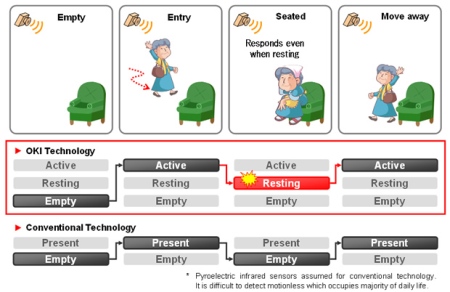Oct 9 2012
OKI recently developed a human-detecting sensor technology capable of distinguishing between large movements (for example, a person walking about a room) to minute movements like breathing.
 Comparative example with existing technology: A daily life situation (give it as heading for pic); Detection when a person enters an empty room and sits in a chair: Identifies changes in behavior
Comparative example with existing technology: A daily life situation (give it as heading for pic); Detection when a person enters an empty room and sits in a chair: Identifies changes in behavior
This technology can detect even the minute movements of otherwise motionless persons, making it suitable for use in various applications, including advance warnings of health problems. OKI is currently seeking to apply this technology to areas ranging from security to the monitoring of elderly or people requiring long-term care.
Use of pyroelectric infrared human-sensing sensors continues to grow for a wide range of applications involving the detection of humans in fields from security to monitoring and energy conservation. While this area of technology has been successfully applied to detect moving persons, it has been less successful in detecting people who are motionless. Focusing on microwave sensors that rely on the Doppler effect to penetrate and circumvent obstructions and allow detection and response to minute movements, such as breathing and heartbeats, OKI has pursued research on highly-sensitive methods for detecting human presence and behavior.
Previously used in certain human-detection applications, microwave sensors have suffered from certain shortcomings: when a single sensor is used to provide wide coverage over the typical room-sized space, in addition to actual motion inside the area being monitored, movements of air-conditioning equipment in the same area and movements of people or vehicles outside the space are also detected. These shortcomings made these sensors ill-suited to applications involving more than sensing localized large movements (e.g., automatic doors or gate monitoring installations).
OKI explored the differences in fluctuations caused by the movement of physical bodies, developing a statistical model to extract human movement with high precision while disregarding the effects of objects moving in the surroundings. Large volumes of test data were collected to simulate the environmental factors likely to be found in a typical home. In partnership with the Chuo University Statistical Data Analysis Group led by Professor Toshinari Kamakura, OKI analyzed this store of data to refine the model. The technology ultimately developed proved capable of detecting motionless humans based on minute movements, such as breathing, at levels of high precision unaffected by environmental factors.
"This technology can distinguish in real-time between resting and moving states. The detection results can also be aggregated to allow visualization of small changes in daily behavioral patterns," says Takeshi Kamijoh, General Manager of Research and Development Center at OKI. "Future work will refine this technology to incorporate functions capable of detecting breathing and heartbeats or anomalous behavior. The associated data can be aggregated and analyzed over a cloud network to ensure early detection of problems, such as falling or health-related irregularities, and rapid response."
The microwave sensors on which this technology is based do not require exposed sensor units, allowing the configuration of discreet, nonintrusive systems to reduce discomfort in privacy-sensitive locations. The sensors are capable of detecting motion through furniture or bedding and are unaffected by ambient temperature fluctuations or heat sources such as heaters, allowing use even in hot and humid locations like bathrooms. The technology is expected to be ideal for monitoring patients in homes or in hospitals.
OKI plans to apply such smart sensing technology to provide systems and solutions that contribute to a smart society. OKI will also seek to apply this technology to build a healthier society, one offering increased peace of mind, through demonstrations in smart communities and smart homes.